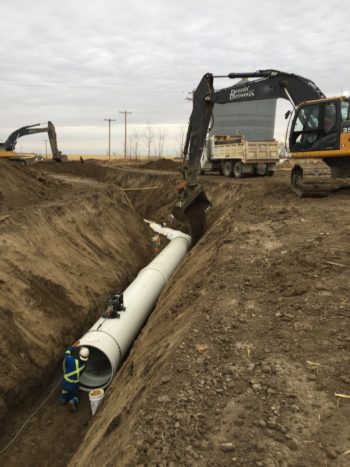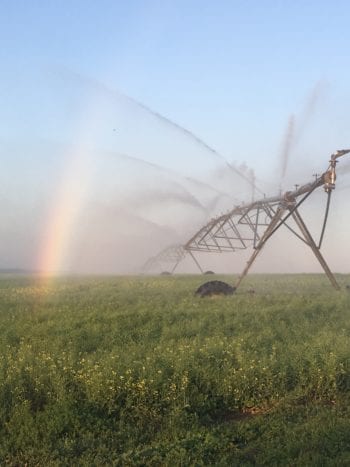With Alberta’s irrigation infrastructure undergoing an almost billion-dollar upgrade and Saskatchewan expanding its own system, water is aplenty in the West.
Irrigation is an important part of potato growing across Canada. And on the Prairies, multiple irrigation infrastructure projects are currently happening. In Alberta, the province is in the midst of an almost billion-dollar project to modernize its irrigation infrastructure, while their eastern neighbour in Saskatchewan are expanding their irrigation system around Lake Diefenbaker.
Southern Alberta’s irrigation system has kept crops growing no matter the weather for more than a century. Over the years, the irrigation districts have updated their systems to keep them running. However, now through a new partnership with the province, the irrigation infrastructure is undergoing a massive update.
“Irrigation is in the fabric of southern Alberta. And this just helps us manage a really important resource in a very effective and responsible way,” David Westwood, general manager of the St. Mary River Irrigation District (SMRID), explains in a phone interview. “Our whole mandate —through when we expand and want to be able to add acres to southern Alberta — will be that we’re doing it with the same or even less water than we have been currently using.”
In Saskatchewan, the province is working to expand their irrigation infrastructure by 500,000 acres over the next decade.
“We’re still at pretty early stages in early days, something of this magnitude is going to take time,” Patrick Boyle, spokesperson for the Saskatchewan Water Security Agency, says in a phone interview. “At the end of the day, it’s for the people of Saskatchewan. I’ll be built by the people of Saskatchewan. So, it’s for kind of a transformational look for our province.”
Modernizing Alberta’s Irrigation System
There are 13 irrigation districts within Alberta, mainly concentrated in the southern part of the province, covering 1.5 million acres with 42 storage reservoirs. A report from the Alberta Irrigation Districts Association published in November 2021 titled the Economic Value of Alberta’s Irrigation Districts, found that between 2011 to 2018, irrigation from the area annually generated $5.4 billion to provincial GDP, $3.2 billion in labour income and supported about 46,000 full-time jobs.
It was also found irrigation district land represent only 4.4 per cent of Alberta’s cultivated land base, but generate 27 per cent of the province’s total primary agricultural sales and contribute 28 per cent to Alberta’s total agri-food GDP. The study also examined the impact of irrigation infrastructure funding on government revenues. It was found that for every dollar invested by the Alberta government on irrigation district related activities added $3.56 in revenue to the provincial government.

In the spring of 2020, the Alberta government put out a call for stimulus project ideas. At the time, irrigation districts in the province had been planning various upgrades to their systems, but when they saw the callout they realized they could complete their projects with government support on a shorter timeline.
“The districts were asked to submit projects they could do. We were given the guidelines of shovel ready or near shovel ready — (projects) that we could start doing fairly quickly. A lot of our districts had these projects on the drawing board,” Westwood explains.
In the fall of 2020, it was announced there would be $815 million in irrigation system upgrades done. The investment would be funded by the irrigation districts and government, with $407.5 million coming from the Canada Infrastructure Bank (CIB), $244.5 million from the province and $163 million from the irrigation districts. The irrigation districts would also pay back the CIB portion.
A news release at the time said the project would create more than 200,000 acres of irrigated land, increase primary crop production, improve water use efficiency, increase water storage capacity, enhance water security, and provide flood protection to support long-term value-added processing activity.
In November 2021, another $117.7 million was invested by the provincial government and CIB. A news release from the government said the increased investment has the potential to expand irrigation by up to 230,000 acres.
The modernization project started last year, with the pipeline projects scheduled to be complete by the summer of 2025 and reservoir projects by the spring of 2028. According to Westwood, every irrigation district has started on their projects, with some further along than others. Some are in the planning stages while others will have their projects done by Christmas 2021.
In Westwood’s own irrigation district, SMRID, they are working on a pipeline project that had originally been designed 15 years ago but was shelved due to challenges receiving approvals and agreements with landowners for construction.
“I know, talking personally to some of those impacted irrigators on that particular project, they are very excited that they’re finally getting a pipeline. Their old conveyance channels were one of the oldest ones that we had in the district, and were dirt conveyance in some cases,” he says.
The irrigation modernization project means what is already an extremely diversified growing region can become even more diversified, Trevor Lewington, the CEO of Economic Development Lethbridge, which is located in the irrigation region, says.
“It adds new storage capacity, so that’s good news. Expanding the Chin reservoir system means there’s more water made available,” he explains in a phone interview. “That does add more acres under irrigation, which again allows either more production of the same crops or potentially more specialized crops than we currently do today.”
In recent years, potato production has expanded in the province with Cavendish Farms building a new processing plant in Lethbridge, Alta. Terence Hochstein, executive director of the Potato Growers of Alberta, says the modernization project will allow for the potato industry in the province to expand even more possibly.
“We should be able to irrigate more acres with the same amount of water because of these efficiency gains. And it’ll open up some new ground that was previously dry land that could now be considered irrigation — grown for potatoes and other crops,” Hochstein explains in a phone interview.
Update on Saskatchewan’s Irrigation Project
In the summer of 2020, the Saskatchewan government announced a $4 billion-decade long project to expand the province’s irrigation by 500,000 acres. The project is focused around Lake Diefenbaker and will pick up on previous plans to expand the province’s irrigation infrastructure.

In February 2021, the prime consultant was hired for the project. A consortium of Clifton Associates Ltd. and Stantec will create the pre-design, do environmental work and support engagement with stakeholders and Indigenous rights holders, Boyle says.
Work is well underway for the project, he adds. Currently work is focusing on the west side rehabilitation expansion and is in the design and pre-engineering stage. There’s initial work such as soil testing and environmental baseline studies happening in order to gather information.
The west side rehabilitation expansion will rehabilitate the current 42 kilometres of canals and pumps on the west side of Lake Diefenbaker. There will also be irrigation infrastructure built north of Conquest, Sask.
“We don’t have an exact timeline, because a lot of that information, and how we get to that is informed by our predesigned pre-engineering work. So, till we have all of that work done, which could take a number of months, it will be into 2022 for sure (before we start construction),” Boyle explains.
The Water Security Agency was able to host a series of open houses in Delisle and Outlook, which are in the region covered by the west side project, during the winter in 2021. There was also an open house held at the Dakota Dunes Casino to engage with Indigenous and Métis peoples in the area. Doyle says in general, public response to the project has been positive so far.
Header photo — A potato field in southern Alberta that is watered by irrigation. Photo: St. Mary River Irrigation District
Related Articles
Water Freedom for P.E.I. Potato Growers








